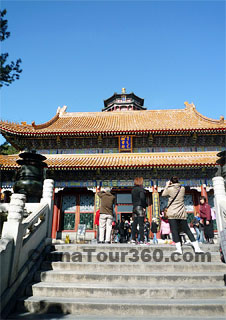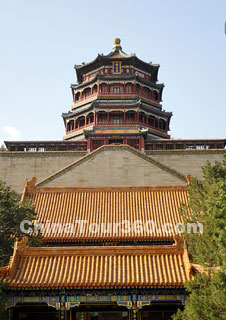Quite a few scenic areas in the Summer Palace are based on Longevity Hill. Previously known as Weng Mountain, Longevity Hill is a range of the Yanshan Mountas and a branch of Beijing Western Hills, with a height of 58.59 meters (192 feet). In the beginning, the area around Weng Mountain was a barren place in the northwest suburb of Beijing. Through hard working of generations, the lakesides were developed as rice field, water caltrop, lotus and mushroom were planted in the lake. As a result, the wilderness was turned into a beautiful land with the scenery of the water towns south of the Yangtze River. In the reign of Emperor Qianlong, the emperor changed the name into 'Longevity Hill' to celebrate the birthday of his mother, hence its name.
In the previous year before the name was changed, the Temple of Paying Great Gratitude for Longevity (Dabao’en Yanshou Si) was built on the former site of the Temple of Perfect Tranquility (Yuanjingsi). Then Kunming Lake was expanded and the earth dug from the lake was piled on the hill to make its east and west slope even and symmetric. The buildings were then all built upon the Hill, centering on three building groups of unique style and feature - Front Hill Area, Scattered Sights Area and Rear Hill Area.
The front-hill scenic area of the Longevity Hill has the most buildings of the Summer Palace, which are all masterpieces of ancient Chinese architectures. This scenic area is dominated by two vertical and symmetric axes. The Long Corridor is the east-west axis. The south-north axis starts from the central part of the Long Corridor, consisting of the Gate of Dispelling Clouds (Paiyun Men), the Hall of Dispelling Clouds (Paiyun Dian), the Hall of Virtuous Splendor (Dehui Dian), the Tower of Buddhist Incense (Foxiang Ge) and the Sea of Wisdom Temple (Zhihui Hai) on the top of the hill.
![]() Long Corridor
Long Corridor
Being the longest corridor in the classic China gardens and the longest gallery in the world, the Long Corridor starts from the Gate of Greeting the Moon (Yaoyue Men) of the Hall of Happiness and Longevity in the east, and ends at the Shizhang Pavilion in the west. It is 2.28 meters (2.5 yards) wide, covering a distance of 728 meters (796 yards) with 273 sections. The corridor is actually an art gallery, featuring more than 14,000 colorful pictures of landscapes, flowers, birds, figures, mountains and rivers on its beams, ceilings and eaves. It is an excellent carrier of the Chinese culture, including traditional art, history and literature. Along the corridor, there are four elegant octagonal pavilions at the joints where the terrain or orientation changes, representing the four seasons of a year.
![]() Hall of Natural Affinity of Water and Trees (Shuimu Ziqin Dian)
Hall of Natural Affinity of Water and Trees (Shuimu Ziqin Dian)
Hall of Natural Affinity of Water and Trees is the gate of the Hall of Happiness and Longevity, with a stone pier and railings in front. Empress Dowager Cixi used to board at this pier when she entered or exited the Summer Palace by water. In 1908, the Qing Government opened the special phone line linking the Hall of Natural Affinity of Water and Trees of the Summer Palace with a side hall of the Western Gardens (Xiyuan) in Zhongnanhai for Empress Dowager Cixi and Empire Guangxu. It is the first royal phone line in Chinese history. The opening of it made the Summer Palace the command center of politics, military and foreign affairs of China at that time. Now the Hall of Natural Affinity of Water and Trees is the exhibition hall for royal phone lines.
![]() Gate of Dispelling Clouds (Paiyun Men)
Gate of Dispelling Clouds (Paiyun Men)
Gate of Dispelling Clouds is the entrance of the Hall of Dispelling Clouds. In front of the gate, there is a memorial archway, which is the starting point of the south-north architectural axis of the Longevity Hill. Outside the memorial archway was the pier especially for Empress Dowager Cixi who would free captive animals on the 15th day of April in lunar calendar every year.
![]() Hall of Dispelling Clouds (Paiyun Dian)
Hall of Dispelling Clouds (Paiyun Dian)
Located in the central part of the Longevity Hill, the Hall of Dispelling Clouds was originally the Temple of Paying Great Gratitude for Longevity (Dabao’en Yanshou Si) built under the order of Emperor Qianlong for his mother’s 60th birthday. The temple was burnt down by the Anglo-French Allied Forces in 1860. In 1887, it was rebuilt and renamed ‘Hall of Dispelling Clouds’ by Empress Dowager Cixi. Behind the Hall is the Hall of Virtuous Splendor there was the place for Empress Dowager Cixi to change clothes when she worshipped the Buddha in the Tower of Buddhist Incense. The two halls were connected by a hillside corridor.

Hall of Dispelling Clouds

Tower of Buddhist Incense
![]() Tower of Buddhist Incense (Foxiang Ge)
Tower of Buddhist Incense (Foxiang Ge)
A scenic spot that can’t be missed, the Tower of Buddhist Incense is a representative and also the most magnificent and grand building in the Summer Palace. Constructed during the reign of Emperor Qianlong (1736 - 1795AD), it is an octahedron three-storey four-tier roof building, standing on a 20 meter (66 feet) high stone foundation. In addition to the tower itself, the whole building is 36.44 meters (119.6 feet) high in total, appearing very magnificent. The tower glows with beauty and grandeur against the eight supporting pillars made of pear wood, regarded as of considerable cultural and artistic value. Standing on the tower, you will have a panoramic view of the Kunming Lake,Yuquan Hill (Jade Spring Hill), and even the whole Summer Palace. In the tower are worshipped the standing statue of the Thousand-hand Bodhisattva cast with bronze and gilded with gold. The statue is five meters (16 feet) in height and five tons in weight, made during the reign of Emperor Wanli (1573 - 1620 AD) of the Ming Dynasty.
The corridors of the Tower of Buddhist Incense are typical one-side corridors, which are supported with pillars on one side and are closed with walls on the other. They enclose the tower into a square courtyard.
![]() Sea of Wisdom Temple (Zhihui Hai)
Sea of Wisdom Temple (Zhihui Hai)
Like the Tower of Buddhist Incense, the name ‘Sea of Wisdom Temple’ also originates from the Buddhism, meaning that the virtue and wisdom of the Buddha are as boundless as the sea. The Sea of Wisdom Temple appears like a wood structure, but was built with bricks and stones without any wood in fact. It is also known as 'Amitayus Hall' for the Amitayus Buddha is worshipped in the hall. Because of being non-wood structure, it survived the wars. However, the niches for Buddha statue in the hall and the 1110 Buddha statues in the outside walls all suffered some degree of damage.
![]() Revolving Archives (Zhuanlun Zang)
Revolving Archives (Zhuanlun Zang)
There is a stone tablet with Emperor Qianlong’s authentic calligraphy on sitting in the east yard of the Sea of Wisdom Temple, called Kunming Lake Tablet. Behind the tablet is a wooden temple of Tibetan Buddhism, namely, the Revolving Archives. The temple was built in 1750, and was originally a yard of the Temple of Paying Great Gratitude for Longevity. It survived the wars miraculously, but all the artifacts and figures of Buddha in the hall were ransacked.
![]() Baoyun Pavilion (Baoyun Ge)
Baoyun Pavilion (Baoyun Ge)
Also known as 'Bronze Hall' or 'Golden Hall', the Baoyun Pavilion built in 1775 is another survivor from the wars. Its uniqueness lies in that its whole body was cast with bronze, so it has a high scientific and artistic value. Although it survived the wars, all the articles in it were plundered, leaving only a bronze table of 20 tons. 10 bronze windows of the pavilion moved out of China were purchased and presented to the Summer Palace by American International Group (AIG) in 1993.
![]() Go to the Next Scenic Area: Longevity Hill - Rear Hill Area
Go to the Next Scenic Area: Longevity Hill - Rear Hill Area








